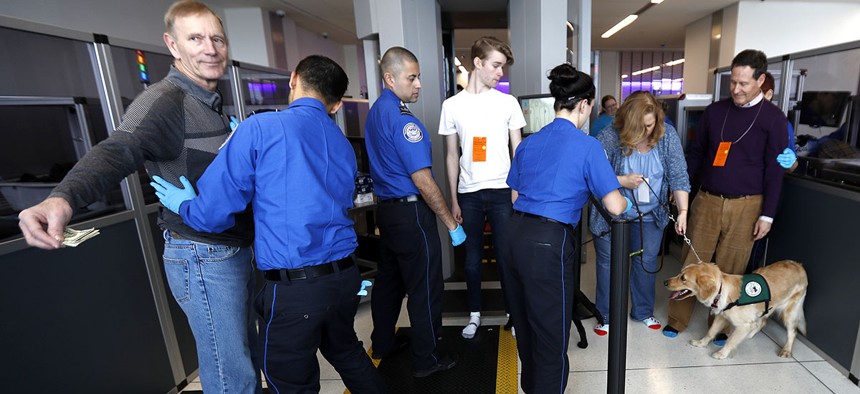DHS Achieves an Acquisition First for the Agency

A traveler, left, is padded by a TSA agent as trainers, top right, lead their service dogs through the security area at Newark Liberty International Airport while taking part of a training exercise, Saturday, April 1, 2017. Julio Cortez/AP
The department's acquisition programs have struggled for years, but there are signs of a turnaround.
The Homeland Security Department's acquisition struggles have been in Congress’ crosshairs for years and were again highlighted in the Government Accountability Office's High-Risk list this February. A new GAO audit, however, suggests progress addressing those issues.
Released this week, the audit states all 26 acquisition programs GAO reviewed met department-approved cost, schedule and performance baselines to measure progress “for the first time since GAO began its annual assessments” three years ago, with more than half the programs on track to meet initial cost goals.
The audit covers DHS acquisitions over fiscal 2016, which total approximately $7 billion spent on ships, surveillance technology at the border, screening equipment at airports and other equipment.
» Get the best federal technology news and ideas delivered right to your inbox. Sign up here.
“DHS has taken steps to strengthen management of its major acquisitions,” the audit stated. “But some programs continued to fall short of their goals.”
Of the 17 programs analyzed on track to meet cost or schedule goals, two reduced cost or improved their schedules. The Customs and Border Protection’s Non-Intrusive Inspection Systems Program slashed costs by $190 million over 2016, while the U.S. Coast Guard’s C4ISR program improved its rollout time by 21 months.
But GAO noted seven of the 17 programs had only established first-time goals since the watchdog’s prior review in 2016. In addition, GAO stated nine DHS acquisition programs experienced schedule slips, while four experienced cost increases.
Programs at Transportation Security Administration performed poorly enough to skew DHS’ statistics. For example, its Technology Infrastructure Modernization effort jumped $128 million in cost and ballooned in schedule by 75 months. The Transportation Security Administration's Passenger Screening Program was delayed almost two years in 2016, as was its Electronic Baggage Screening Program. EBSP also had the distinction of achieving the highest cost overrun at $975 million.
GAO made three recommendations to DHS to continue the momentum it has made in addressing acquisition issues. Two of the recommendations would require updates to acquisition policy. DHS should, according to GAO, define key technical requirements prior to approving programs. In addition, GAO recommends DHS leadership “clearly document the rationale” and reasons for allowing certain programs to deviate from requirements.
Lastly, GAO suggests DHS should specify when minimum standards for key performance parameters should be met, “and clarify the performance data that should be used to assess whether or not a performance breach has occurred.”



